Structural and Optical Characterization of Mechanochemically Synthesized CuSbS2 Compounds
Abstract
:1. Introduction
2. Materials and Methods
3. Results and Discussion
4. Conclusions
Author Contributions
Funding
Institutional Review Board Statement
Informed Consent Statement
Data Availability Statement
Acknowledgments
Conflicts of Interest
References
- Zendehdel, M.; Nia, N.Y.; Yaghoubinia, M. Emerging Thin Film Solar Panels. In Reliability and Ecological Aspects of Photovoltaic Modules; Gok, A., Ed.; IntechOpen: London, UK, 2020; p. 26. ISBN 0000957720. [Google Scholar] [CrossRef] [Green Version]
- Jean, J.; Brown, P.R.; Jaffe, R.L.; Buonassisi, T.; Bulović, V. Pathways for Solar Photovoltaics. Energy Environ. Sci. 2015, 8, 1200–1219. [Google Scholar] [CrossRef]
- Taylor, N.; Jäger-Waldau, A. Photovoltaics Technology Development Report 2020; Joint Research Centre (JRC), Publications Office of the European Union: Luxembourg, 2020; ISBN 9789276272748. [Google Scholar]
- Photovoltaics Report; Fraunhofer Institute for Solar Energy Systems, ISE: Freiburg, Germany, 2022.
- Smith, B.L.; Woodhouse, M.; Horowitz, K.A.W.; Silverman, T.J.; Zuboy, J.; Margolis, R.M. Photovoltaic (PV) Module Technologies: 2020 Benchmark Costs and Technology Evolution Framework Results; NREL/TP-7A40-78173; National Renewable Energy Laboratory: Golden, CO, USA, 2021.
- Divitini, G.; Cacovich, S.; Matteocci, F.; Cinà, L.; Di Carlo, A.; Ducati, C. In Situ Observation of Heat-Induced Degradation of Perovskite Solar Cells. Nat. Energy 2016, 1, 15012. [Google Scholar] [CrossRef] [Green Version]
- Feltrin, A.; Freundlich, A. Material Considerations for Terawatt Level Deployment of Photovoltaics. Renew. Energy 2008, 33, 180–185. [Google Scholar] [CrossRef]
- Bae, S.; Kim, S.; Lee, S.-W.; Cho, K.J.; Park, S.; Lee, S.; Kang, Y.; Lee, H.-S.; Kim, D. Electric-Field-Induced Degradation of Methylammonium Lead Iodide Perovskite Solar Cells. J. Phys. Chem. Lett. 2016, 7, 3091–3096. [Google Scholar] [CrossRef]
- Mbumba, M.T.; Malouangou, D.M.; Tsiba, J.M.; Bai, L.; Yang, Y.; Guli, M. Degradation Mechanism and Addressing Techniques of Thermal Instability in Halide Perovskite Solar Cells. Sol. Energy 2021, 230, 954–978. [Google Scholar] [CrossRef]
- Zakutayev, A. Brief Review of Emerging Photovoltaic Absorbers. Curr. Opin. Green Sustain. Chem. 2017, 4, 8–15. [Google Scholar] [CrossRef]
- Peccerillo, E.; Durose, K. Copper—Antimony and Copper—Bismuth Chalcogenides—Research Opportunities and Review for Solar Photovoltaics. MRS Energy Sustain. 2018, 5, 9. [Google Scholar] [CrossRef] [Green Version]
- Pal, K.; Singh, P.; Bhaduri, A.; Thapa, K.B. Current Challenges and Future Prospects for a Highly Efficient (>20%) Kesterite CZTS Solar Cell: A Review. Sol. Energy Mater. Sol. Cells 2019, 196, 138–156. [Google Scholar] [CrossRef]
- Nazligul, A.S.; Wang, M.; Choy, K.L. Recent Development in Earth-Abundant Kesterite Materials and Their Applications. Sustainability 2020, 12, 5138. [Google Scholar] [CrossRef]
- Wang, W.; Winkler, M.T.; Gunawan, O.; Gokmen, T.; Todorov, T.K.; Zhu, Y.; Mitzi, D.B. Device Characteristics of CZTSSe Thin-Film Solar Cells with 12.6% Efficiency. Adv. Energy Mater. 2014, 4, 1301465. [Google Scholar] [CrossRef]
- De Souza Lucas, F.W.; Zakutayev, A. Research Update: Emerging Chalcostibite Absorbers for Thin-Film Solar Cells. APL Mater. 2018, 6, 084501. [Google Scholar] [CrossRef]
- Banu, S.; Ahn, S.J.; Ahn, S.K.; Yoon, K.; Cho, A. Fabrication and Characterization of Cost-Efficient CuSbS2 Thin Film Solar Cells Using Hybrid Inks. Sol. Energy Mater. Sol. Cells 2016, 151, 14–23. [Google Scholar] [CrossRef]
- Dutková, E.; Sayagués, M.J.; Fabián, M.; Kováč, J.; Kováč, J.; Baláž, M.; Stahorský, M. Mechanochemical Synthesis of Ternary Chalcogenide Chalcostibite CuSbS2 and Its Characterization. J. Mater. Sci. Mater. Electron. 2021, 32, 22898–22909. [Google Scholar] [CrossRef]
- Ornelas-Acosta, R.E.; Shaji, S.; Avellaneda, D.; Castillo, G.A.; Das Roy, T.K.; Krishnan, B. Thin Films of Copper Antimony Sulfide: A Photovoltaic Absorber Material. Mater. Res. Bull. 2015, 61, 215–225. [Google Scholar] [CrossRef]
- Wan, L.; Ma, C.; Hu, K.; Zhou, R.; Mao, X.; Pan, S.; Wong, L.H.; Xu, J. Two-Stage Co-Evaporated CuSbS2 Thin Films for Solar Cells. J. Alloys Compd. 2016, 680, 182–190. [Google Scholar] [CrossRef]
- Chalapathi, U.; Poornaprakash, B.; Ahn, C.H.; Park, S.H. Two-Stage Processed CuSbS2 Thin Films for Photovoltaics: Effect of Cu/Sb Ratio. Ceram. Int. 2018, 44, 14844–14849. [Google Scholar] [CrossRef]
- Zhang, H.; Xu, Q.; Tan, G. Physical Preparation and Optical Properties of CuSbS2 Nanocrystals by Mechanical Alloying Process. Electron. Mater. Lett. 2016, 12, 568–573. [Google Scholar] [CrossRef]
- Garza, C.; Shaji, S.; Arato, A.; Perez Tijerina, E.; Alan Castillo, G.; Das Roy, T.K.; Krishnan, B. P-Type CuSbS2 Thin Films by Thermal Diffusion of Copper into Sb2S3. Sol. Energy Mater. Sol. Cells 2011, 95, 2001–2005. [Google Scholar] [CrossRef]
- Alqahtani, T.; Khan, M.D.; Lewis, D.J.; Zhong, X.L.; O’Brien, P. Scalable Synthesis of Cu–Sb–S Phases from Reactive Melts of Metal Xanthates and Effect of Cationic Manipulation on Structural and Optical Properties. Sci. Rep. 2021, 11, 1887. [Google Scholar] [CrossRef]
- Cho, A.; Banu, S.; Kim, K.; Park, J.H.; Yun, J.H.; Cho, J.S.; Yoo, J.S. Selective Thin Film Synthesis of Copper-Antimony-Sulfide Using Hybrid Ink. Sol. Energy 2017, 145, 42–51. [Google Scholar] [CrossRef]
- Welch, A.W.; Zawadzki, P.P.; Lany, S.; Wolden, C.A.; Zakutayev, A. Self-Regulated Growth and Tunable Properties of CuSbS2 Solar Absorbers. Sol. Energy Mater. Sol. Cells 2015, 132, 499–506. [Google Scholar] [CrossRef] [Green Version]
- Edley, M.E.; Opasanont, B.; Conley, J.T.; Tran, H.; Smolin, S.Y.; Li, S.; Dillon, A.D.; Fafarman, A.T.; Baxter, J.B. Solution Processed CuSbS2 Films for Solar Cell Applications. Thin Solid Films 2018, 646, 180–189. [Google Scholar] [CrossRef]
- Suehiro, S.; Horita, K.; Yuasa, M.; Tanaka, T.; Fujita, K.; Ishiwata, Y.; Shimanoe, K.; Kida, T. Synthesis of Copper-Antimony-Sulfide Nanocrystals for Solution-Processed Solar Cells. Inorg. Chem. 2015, 54, 7840–7845. [Google Scholar] [CrossRef] [PubMed]
- Septina, W.; Ikeda, S.; Iga, Y.; Harada, T.; Matsumura, M. Thin Film Solar Cell Based on CuSbS2 Absorber Fabricated from an Electrochemically Deposited Metal Stack. Thin Solid Films 2014, 550, 700–704. [Google Scholar] [CrossRef]
- Neves, F.; Stark, A.; Schell, N.; Mendes, M.J.; Aguas, H.; Fortunato, E.; Martins, R.; Correia, J.B.; Joyce, A. Investigation of Single Phase Cu2ZnSnxSb1-XS4 Compounds Processed by Mechanochemical Synthesis. Phys. Rev. Mater. 2018, 2, 075404. [Google Scholar] [CrossRef] [Green Version]
- Neves, F.; Correia, J.B.; Hanada, K.; Santos, L.F.; Gunder, R.; Schorr, S. Structural Characterization of Cu2SnS3 and Cu2(Sn,Ge)S3 Compounds. J. Alloys Compd. 2016, 682, 489–494. [Google Scholar] [CrossRef]
- Baláž, P.; Baláž, M.; Sayagués, M.J.; Eliyas, A.; Kostova, N.G.; Kaňuchová, M.; Dutková, E.; Zorkovská, A. Chalcogenide Quaternary Cu2FeSnS4 Nanocrystals for Solar Cells: Explosive Character of Mechanochemical Synthesis and Environmental Challenge. Crystals 2017, 7, 367. [Google Scholar] [CrossRef] [Green Version]
- Bruker AXS DIFFRAC.EVA v5, Software for the Analysis of 1D and 2D X-Ray Datasets Including Visualization, Data Reduction, Phase Identification and Quantification, Statistical Evaluation. 2019. Available online: https://www.bruker.com/en/products-and-solutions/diffractometers-and-scattering-systems/x-ray-diffractometers/diffrac-suite-software/diffrac-eva.html (accessed on 2 May 2022).
- Bruker AXS DIFFRAC.TOPAS v6, Profile Fitting Based Software for Quantitative Phase Analysis, Microstructure Analysis and Crystal Structure Analysis. 2016. Available online: https://www.bruker.com/en/products-and-solutions/diffractometers-and-scattering-systems/x-ray-diffractometers/diffrac-suite-software/diffrac-topas.html (accessed on 2 May 2022).
- Rietveld, H.M. A Profile Refinement Method for Nuclear and Magnetic Structures. J. Appl. Crystallogr. 1969, 2, 65–71. [Google Scholar] [CrossRef]
- Beleanu, A.; Mondeshki, M.; Juan, Q.; Casper, F.; Felser, C.; Porcher, F. Systematical, Experimental Investigations on LiMgZ (Z = P, As, Sb) Wide Band Gap Semiconductors. J. Phys. D. Appl. Phys. 2011, 44, 475302. [Google Scholar] [CrossRef] [Green Version]
- Viezbicke, B.D.; Patel, S.; Davis, B.E.; Birnie, D.P. Evaluation of the Tauc Method for Optical Absorption Edge Determination: ZnO Thin Films as a Model System. Phys. Status Solidi Basic Res. 2015, 252, 1700–1710. [Google Scholar] [CrossRef]
- Grazulis, S.; Chateigner, D.; Downs, R.T.; Yokochi, A.F.T.; Quiros, M.; Lutterotti, L.; Manakova, E.; Butkus, J.; Moeck, P.; Le Bail, A. Crystallography Open Database—An Open-Access Collection of Crystal Structures. J. Appl. Crystallogr. 2009, 42, 726–729. [Google Scholar] [CrossRef] [PubMed]
- Baláž, P.; Achimovicová, M.; Baláž, M.; Billik, P.; Zara, C.Z.; Criado, J.M.; Delogu, F.; Dutková, E.; Gaffet, E.; Gotor, F.J.; et al. Hallmarks of Mechanochemistry: From Nanoparticles to Technology. Chem. Soc. Rev. 2013, 42, 7571–7637. [Google Scholar] [CrossRef] [PubMed] [Green Version]
- Li, J.; Tan, Q.; Li, J.F. Synthesis and Property Evaluation of CuFeS2-x as Earth-Abundant and Environmentally-Friendly Thermoelectric Materials. J. Alloys Compd. 2013, 551, 143–149. [Google Scholar] [CrossRef]
- Zhang, D.; Yang, J.; Jiang, Q.; Fu, L.; Xiao, Y.; Luo, Y.; Zhou, Z. Ternary CuSbSe2 Chalcostibite: Facile Synthesis, Electronic-Structure and Thermoelectric Performance Enhancement. J. Mater. Chem. A 2016, 4, 4188–4193. [Google Scholar] [CrossRef]
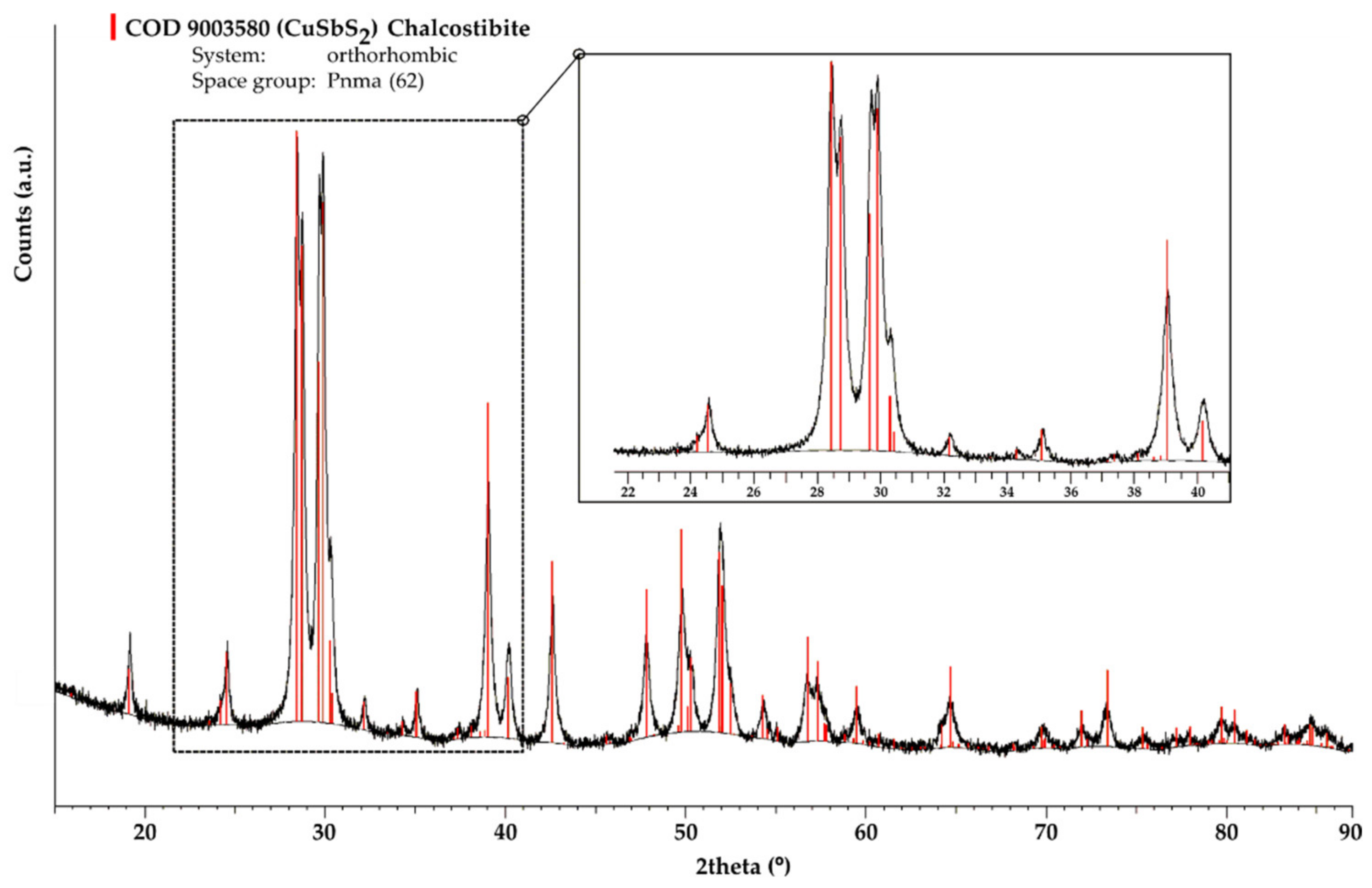


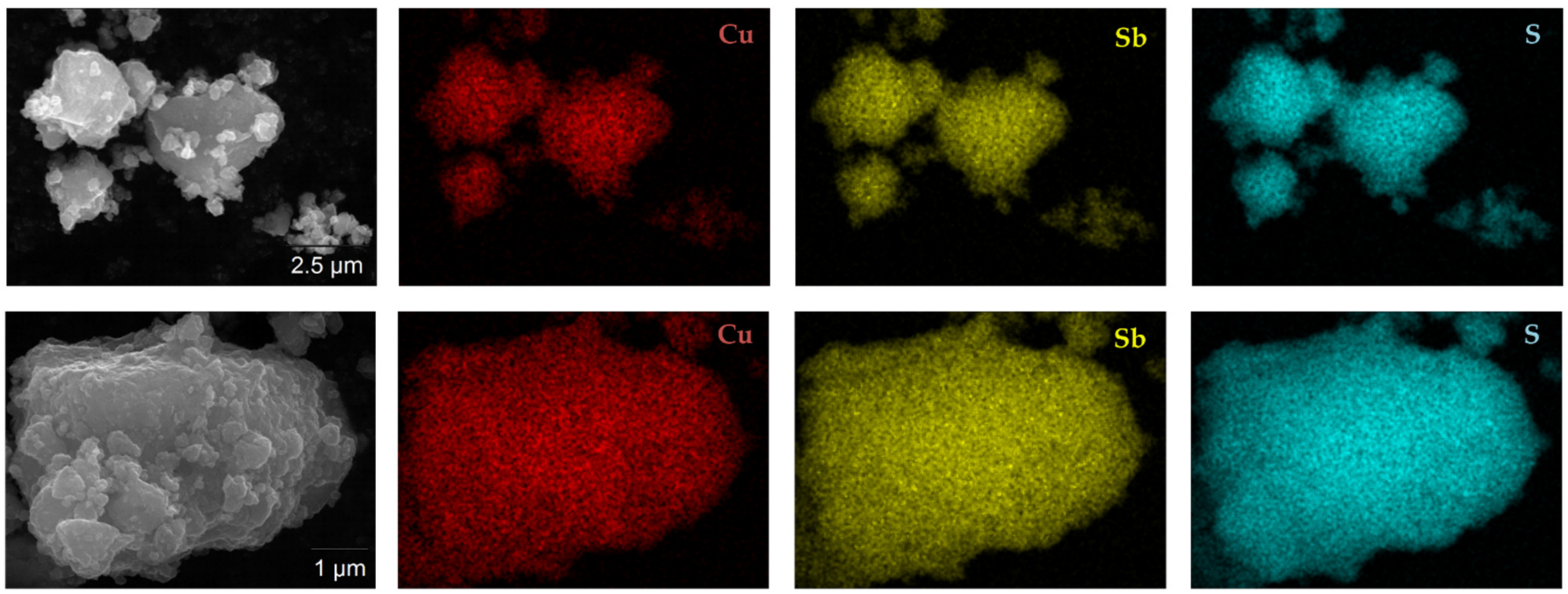
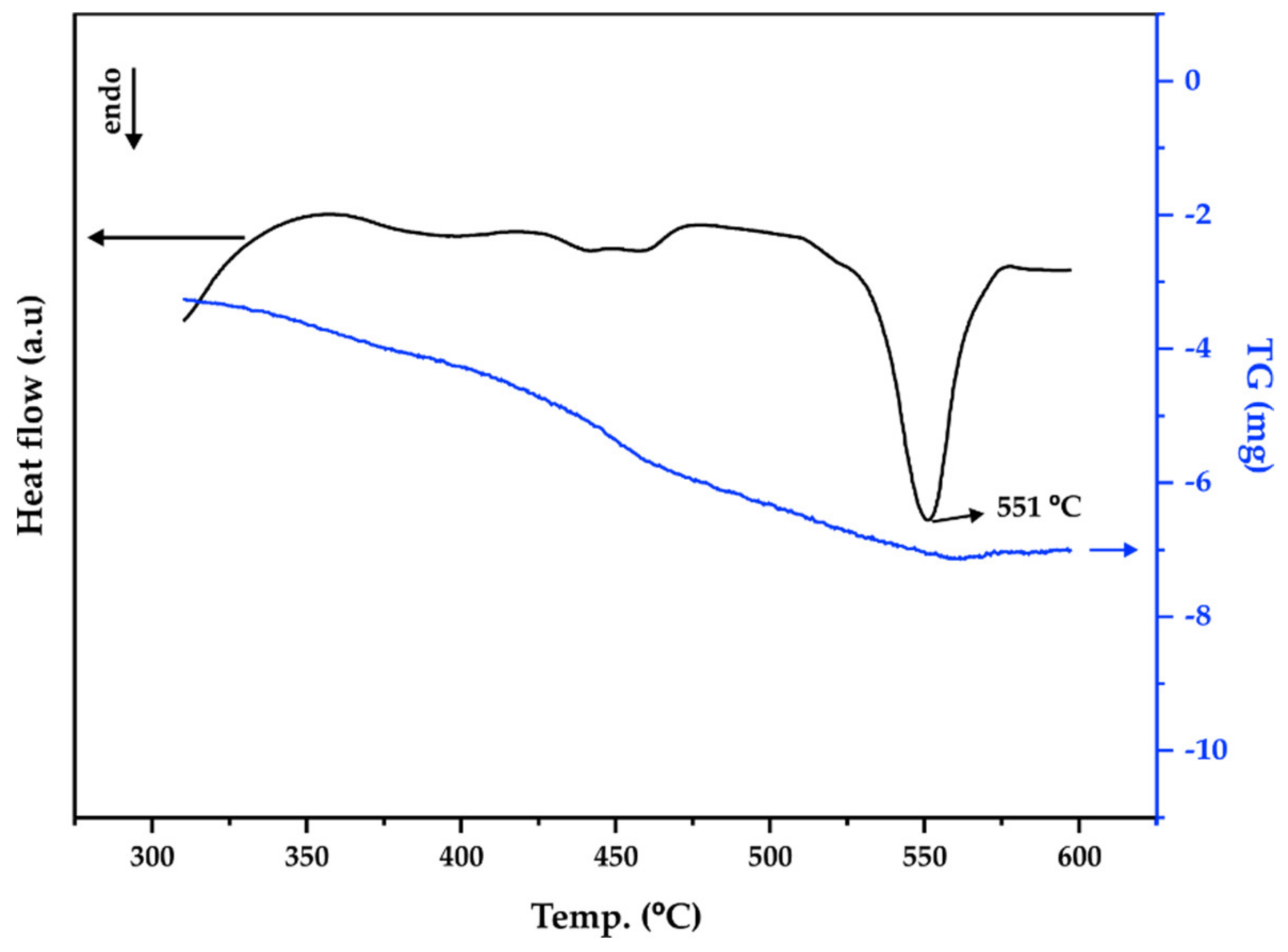
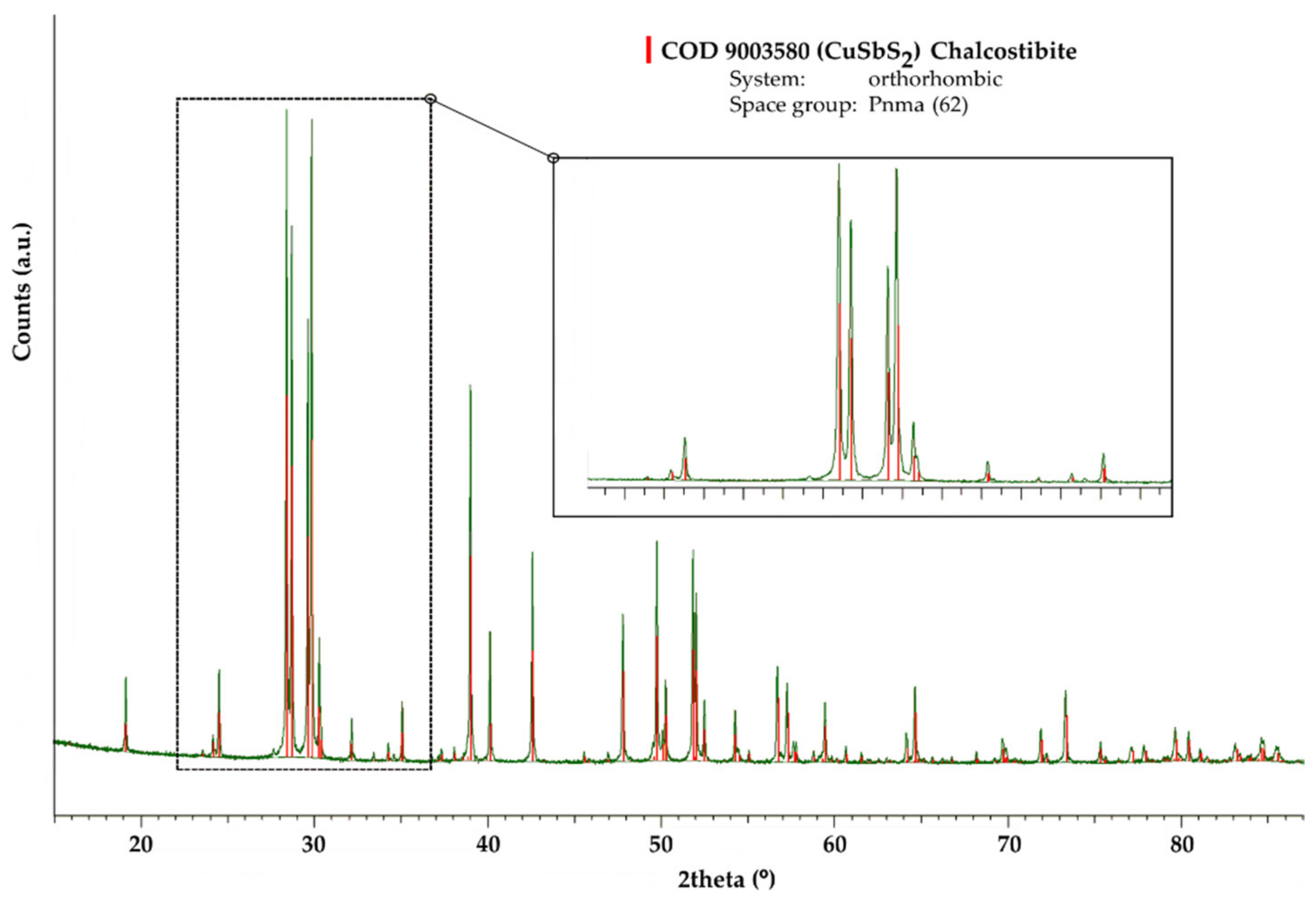
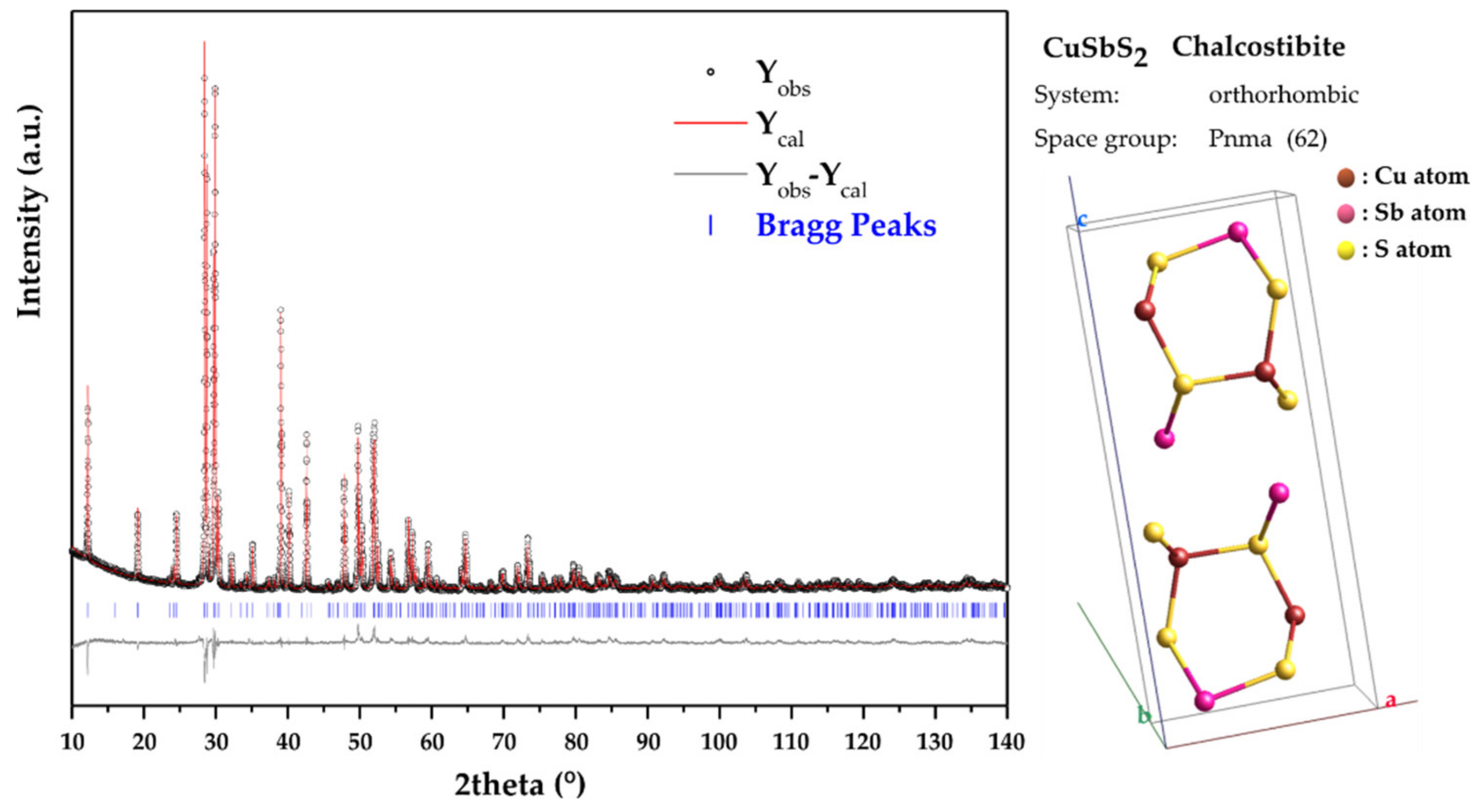

| Lattice Parameter (Å) | MCS | Heat Treated | COD 9,003,580 File |
|---|---|---|---|
| a | 6.0222 (2) | 6.02061 (4) | 6.018 |
| b | 3.80317 (16) | 3.80171 (2) | 3.7958 |
| c | 14.5043 (6) | 14.50051 (10) | 14.495 |
| Element | Site | Atomic Coordinates | ||
|---|---|---|---|---|
| x | y | z | ||
| Cu | 4c | 0.7522 | 0.2500 | 0.6724 |
| Sb | 4c | 0.2260 | 0.2500 | 0.0633 |
| S (1) | 4c | 0.6221 | 0.2500 | 0.0950 |
| S (2) | 4c | 0.3706 | 0.2500 | 0.6756 |
Publisher’s Note: MDPI stays neutral with regard to jurisdictional claims in published maps and institutional affiliations. |
© 2022 by the authors. Licensee MDPI, Basel, Switzerland. This article is an open access article distributed under the terms and conditions of the Creative Commons Attribution (CC BY) license (https://creativecommons.org/licenses/by/4.0/).
Share and Cite
Esperto, L.; Figueira, I.; Mascarenhas, J.; Silva, T.P.; Correia, J.B.; Neves, F. Structural and Optical Characterization of Mechanochemically Synthesized CuSbS2 Compounds. Materials 2022, 15, 3842. https://doi.org/10.3390/ma15113842
Esperto L, Figueira I, Mascarenhas J, Silva TP, Correia JB, Neves F. Structural and Optical Characterization of Mechanochemically Synthesized CuSbS2 Compounds. Materials. 2022; 15(11):3842. https://doi.org/10.3390/ma15113842
Chicago/Turabian StyleEsperto, Luís, Isabel Figueira, João Mascarenhas, Teresa P. Silva, José B. Correia, and Filipe Neves. 2022. "Structural and Optical Characterization of Mechanochemically Synthesized CuSbS2 Compounds" Materials 15, no. 11: 3842. https://doi.org/10.3390/ma15113842
APA StyleEsperto, L., Figueira, I., Mascarenhas, J., Silva, T. P., Correia, J. B., & Neves, F. (2022). Structural and Optical Characterization of Mechanochemically Synthesized CuSbS2 Compounds. Materials, 15(11), 3842. https://doi.org/10.3390/ma15113842







